Leadership and Change Management Report: Analysis of Change Models
VerifiedAdded on 2020/04/21
|12
|3074
|139
Report
AI Summary
This report analyzes leadership and change management principles through the lens of a case study involving Moroccan Lights Co., an Arabic light manufacturing company facing challenges with employee motivation and job satisfaction due to a monotonous work environment. The report explores the importance of job rotation, supported by research, while also examining the advantages and disadvantages of different leadership styles (autocratic, democratic, and transformational) in implementing change. The analysis delves into various change models, including Lewin's, ADKAR, and Kotter's, and discusses the critical role of effective communication in the change process. The report concludes by recommending a transformational leadership approach, emphasizing awareness programs to address employee concerns and foster sustainable organizational change. It also highlights the significance of a well-structured communication plan to ensure the successful implementation of job rotation and improve employee morale and performance.
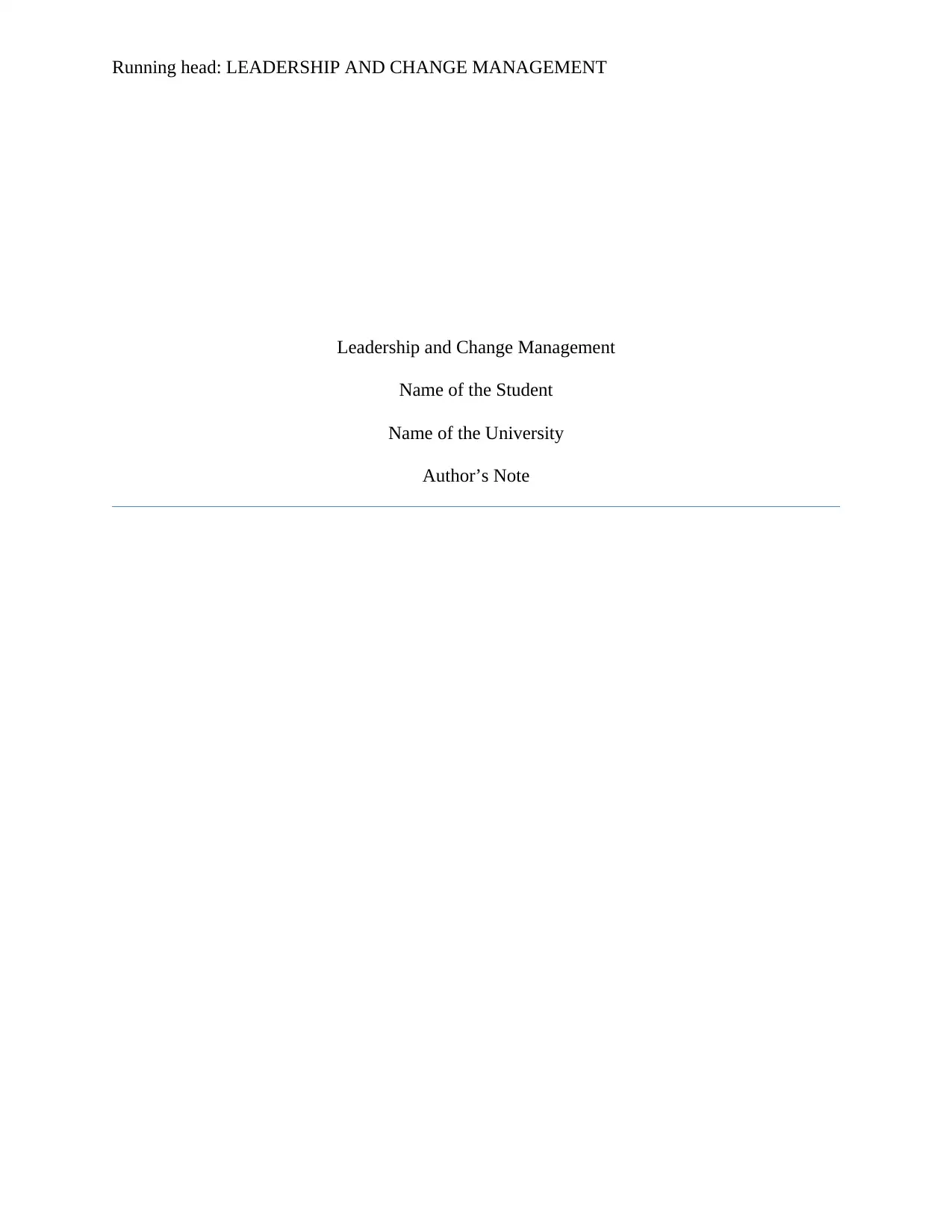
Running head: LEADERSHIP AND CHANGE MANAGEMENT
Leadership and Change Management
Name of the Student
Name of the University
Author’s Note
Leadership and Change Management
Name of the Student
Name of the University
Author’s Note
Paraphrase This Document
Need a fresh take? Get an instant paraphrase of this document with our AI Paraphraser
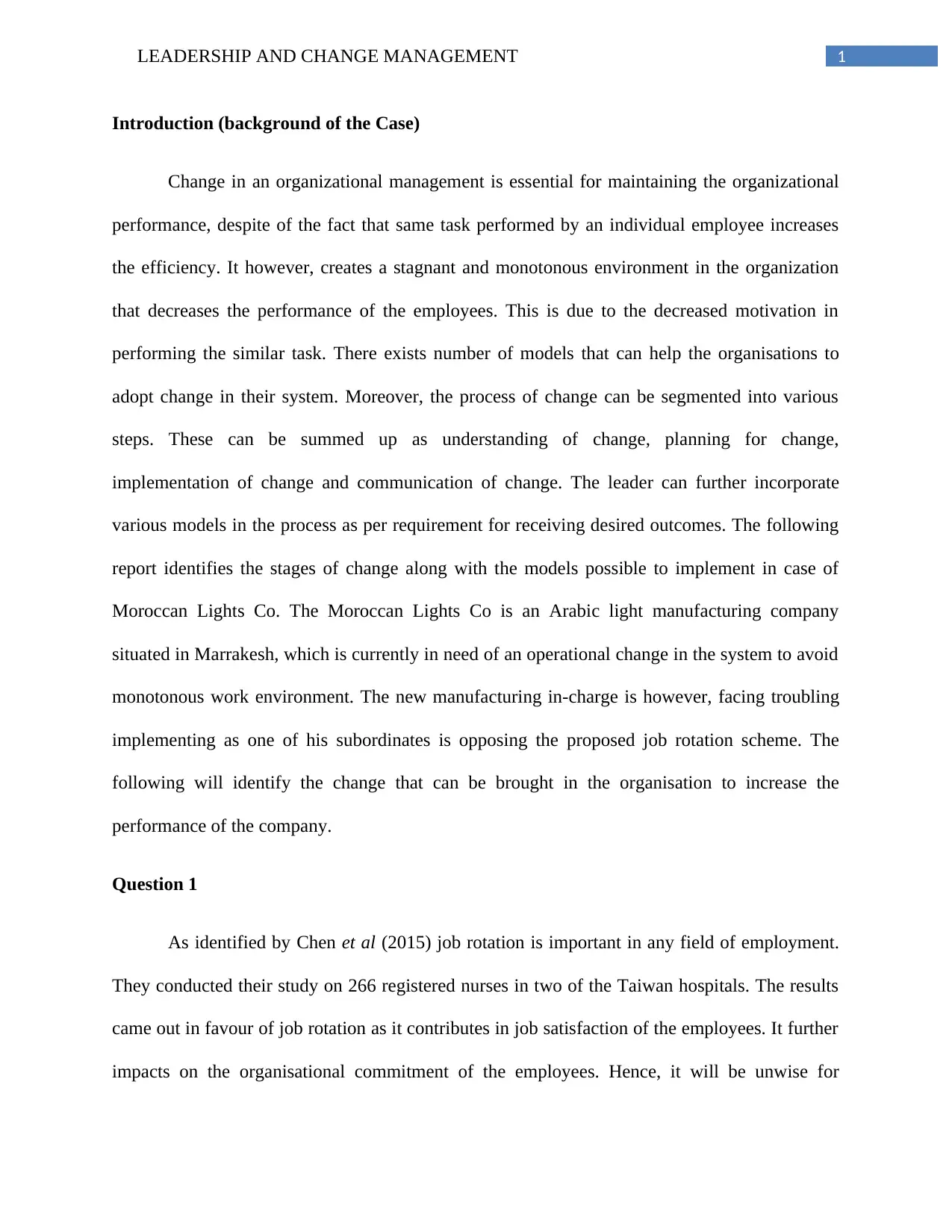
1LEADERSHIP AND CHANGE MANAGEMENT
Introduction (background of the Case)
Change in an organizational management is essential for maintaining the organizational
performance, despite of the fact that same task performed by an individual employee increases
the efficiency. It however, creates a stagnant and monotonous environment in the organization
that decreases the performance of the employees. This is due to the decreased motivation in
performing the similar task. There exists number of models that can help the organisations to
adopt change in their system. Moreover, the process of change can be segmented into various
steps. These can be summed up as understanding of change, planning for change,
implementation of change and communication of change. The leader can further incorporate
various models in the process as per requirement for receiving desired outcomes. The following
report identifies the stages of change along with the models possible to implement in case of
Moroccan Lights Co. The Moroccan Lights Co is an Arabic light manufacturing company
situated in Marrakesh, which is currently in need of an operational change in the system to avoid
monotonous work environment. The new manufacturing in-charge is however, facing troubling
implementing as one of his subordinates is opposing the proposed job rotation scheme. The
following will identify the change that can be brought in the organisation to increase the
performance of the company.
Question 1
As identified by Chen et al (2015) job rotation is important in any field of employment.
They conducted their study on 266 registered nurses in two of the Taiwan hospitals. The results
came out in favour of job rotation as it contributes in job satisfaction of the employees. It further
impacts on the organisational commitment of the employees. Hence, it will be unwise for
Introduction (background of the Case)
Change in an organizational management is essential for maintaining the organizational
performance, despite of the fact that same task performed by an individual employee increases
the efficiency. It however, creates a stagnant and monotonous environment in the organization
that decreases the performance of the employees. This is due to the decreased motivation in
performing the similar task. There exists number of models that can help the organisations to
adopt change in their system. Moreover, the process of change can be segmented into various
steps. These can be summed up as understanding of change, planning for change,
implementation of change and communication of change. The leader can further incorporate
various models in the process as per requirement for receiving desired outcomes. The following
report identifies the stages of change along with the models possible to implement in case of
Moroccan Lights Co. The Moroccan Lights Co is an Arabic light manufacturing company
situated in Marrakesh, which is currently in need of an operational change in the system to avoid
monotonous work environment. The new manufacturing in-charge is however, facing troubling
implementing as one of his subordinates is opposing the proposed job rotation scheme. The
following will identify the change that can be brought in the organisation to increase the
performance of the company.
Question 1
As identified by Chen et al (2015) job rotation is important in any field of employment.
They conducted their study on 266 registered nurses in two of the Taiwan hospitals. The results
came out in favour of job rotation as it contributes in job satisfaction of the employees. It further
impacts on the organisational commitment of the employees. Hence, it will be unwise for
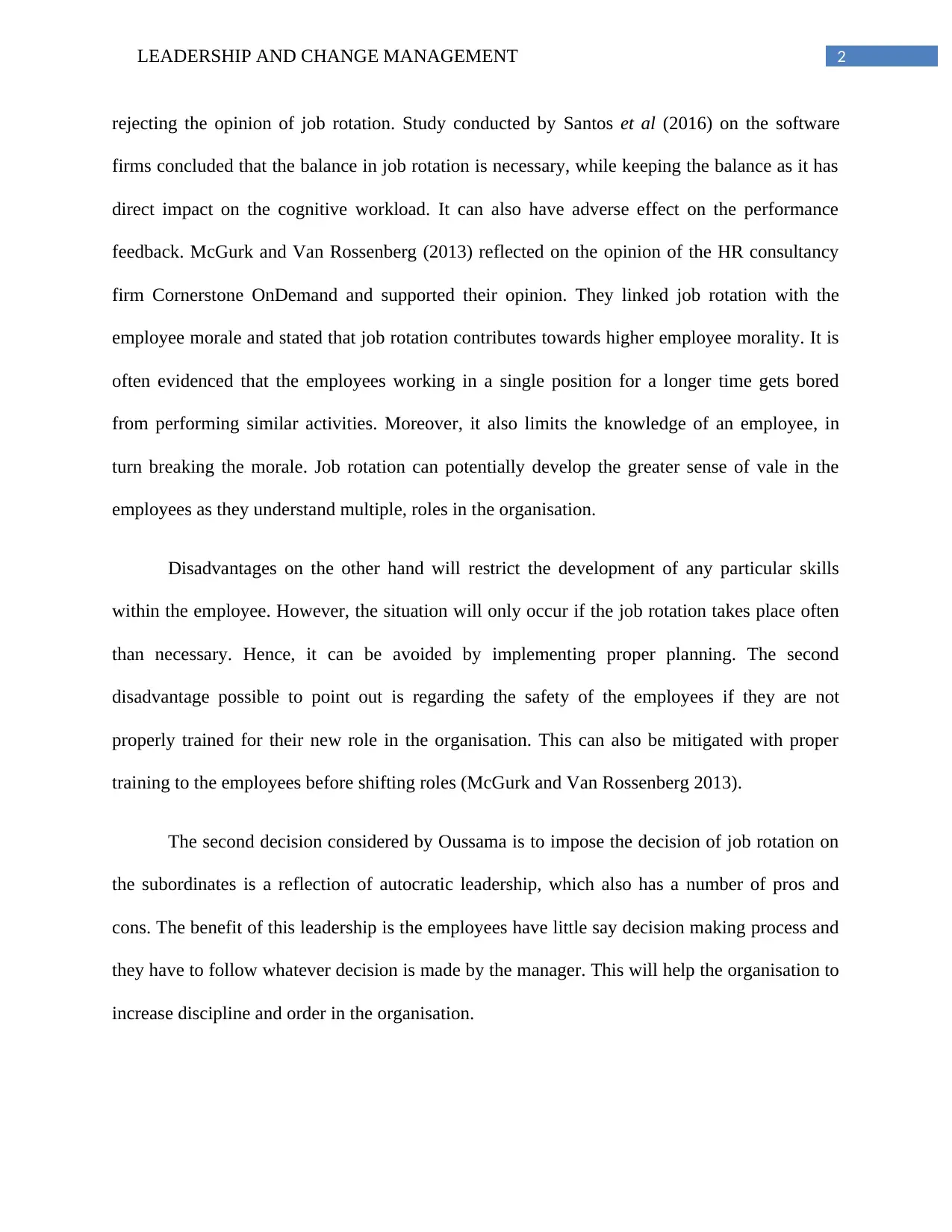
2LEADERSHIP AND CHANGE MANAGEMENT
rejecting the opinion of job rotation. Study conducted by Santos et al (2016) on the software
firms concluded that the balance in job rotation is necessary, while keeping the balance as it has
direct impact on the cognitive workload. It can also have adverse effect on the performance
feedback. McGurk and Van Rossenberg (2013) reflected on the opinion of the HR consultancy
firm Cornerstone OnDemand and supported their opinion. They linked job rotation with the
employee morale and stated that job rotation contributes towards higher employee morality. It is
often evidenced that the employees working in a single position for a longer time gets bored
from performing similar activities. Moreover, it also limits the knowledge of an employee, in
turn breaking the morale. Job rotation can potentially develop the greater sense of vale in the
employees as they understand multiple, roles in the organisation.
Disadvantages on the other hand will restrict the development of any particular skills
within the employee. However, the situation will only occur if the job rotation takes place often
than necessary. Hence, it can be avoided by implementing proper planning. The second
disadvantage possible to point out is regarding the safety of the employees if they are not
properly trained for their new role in the organisation. This can also be mitigated with proper
training to the employees before shifting roles (McGurk and Van Rossenberg 2013).
The second decision considered by Oussama is to impose the decision of job rotation on
the subordinates is a reflection of autocratic leadership, which also has a number of pros and
cons. The benefit of this leadership is the employees have little say decision making process and
they have to follow whatever decision is made by the manager. This will help the organisation to
increase discipline and order in the organisation.
rejecting the opinion of job rotation. Study conducted by Santos et al (2016) on the software
firms concluded that the balance in job rotation is necessary, while keeping the balance as it has
direct impact on the cognitive workload. It can also have adverse effect on the performance
feedback. McGurk and Van Rossenberg (2013) reflected on the opinion of the HR consultancy
firm Cornerstone OnDemand and supported their opinion. They linked job rotation with the
employee morale and stated that job rotation contributes towards higher employee morality. It is
often evidenced that the employees working in a single position for a longer time gets bored
from performing similar activities. Moreover, it also limits the knowledge of an employee, in
turn breaking the morale. Job rotation can potentially develop the greater sense of vale in the
employees as they understand multiple, roles in the organisation.
Disadvantages on the other hand will restrict the development of any particular skills
within the employee. However, the situation will only occur if the job rotation takes place often
than necessary. Hence, it can be avoided by implementing proper planning. The second
disadvantage possible to point out is regarding the safety of the employees if they are not
properly trained for their new role in the organisation. This can also be mitigated with proper
training to the employees before shifting roles (McGurk and Van Rossenberg 2013).
The second decision considered by Oussama is to impose the decision of job rotation on
the subordinates is a reflection of autocratic leadership, which also has a number of pros and
cons. The benefit of this leadership is the employees have little say decision making process and
they have to follow whatever decision is made by the manager. This will help the organisation to
increase discipline and order in the organisation.
⊘ This is a preview!⊘
Do you want full access?
Subscribe today to unlock all pages.

Trusted by 1+ million students worldwide
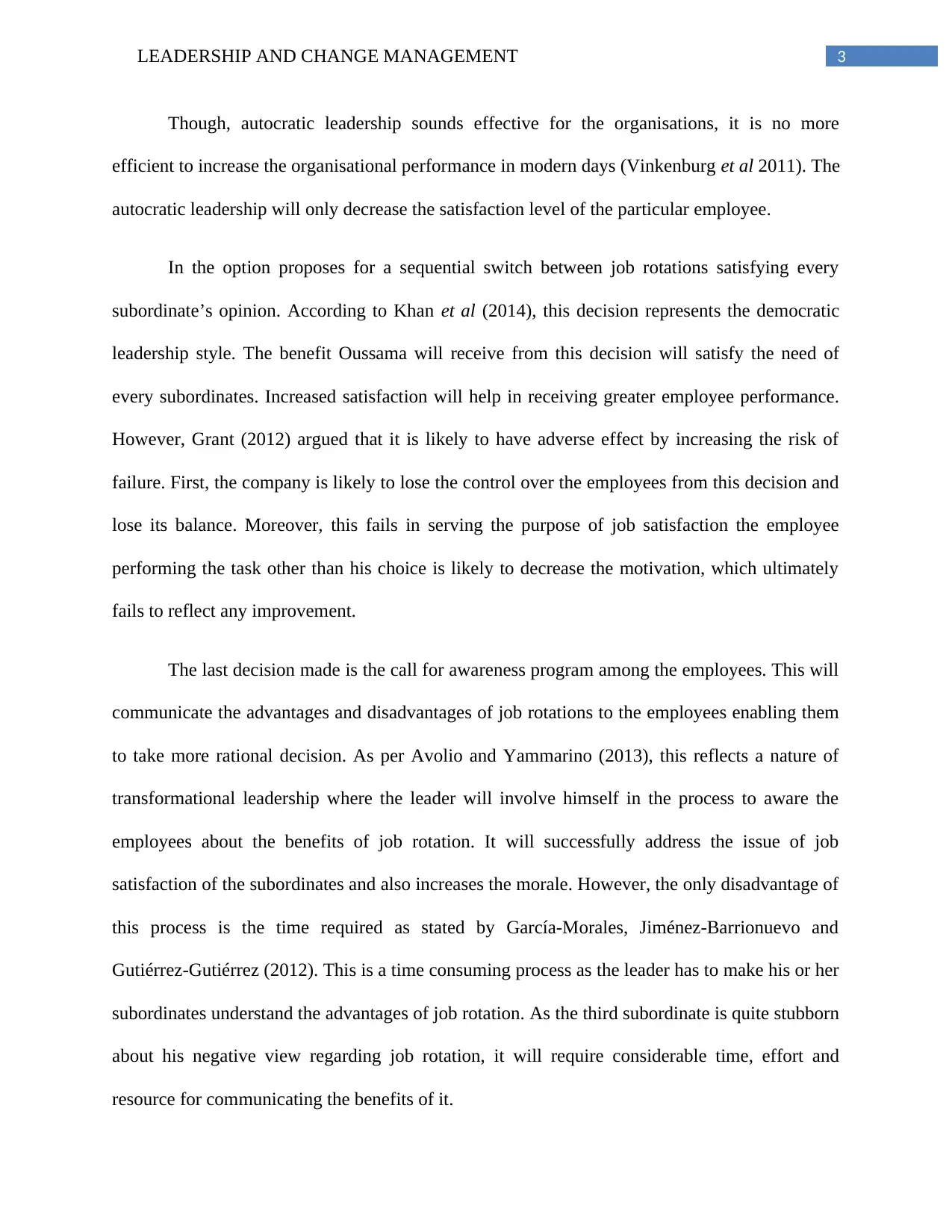
3LEADERSHIP AND CHANGE MANAGEMENT
Though, autocratic leadership sounds effective for the organisations, it is no more
efficient to increase the organisational performance in modern days (Vinkenburg et al 2011). The
autocratic leadership will only decrease the satisfaction level of the particular employee.
In the option proposes for a sequential switch between job rotations satisfying every
subordinate’s opinion. According to Khan et al (2014), this decision represents the democratic
leadership style. The benefit Oussama will receive from this decision will satisfy the need of
every subordinates. Increased satisfaction will help in receiving greater employee performance.
However, Grant (2012) argued that it is likely to have adverse effect by increasing the risk of
failure. First, the company is likely to lose the control over the employees from this decision and
lose its balance. Moreover, this fails in serving the purpose of job satisfaction the employee
performing the task other than his choice is likely to decrease the motivation, which ultimately
fails to reflect any improvement.
The last decision made is the call for awareness program among the employees. This will
communicate the advantages and disadvantages of job rotations to the employees enabling them
to take more rational decision. As per Avolio and Yammarino (2013), this reflects a nature of
transformational leadership where the leader will involve himself in the process to aware the
employees about the benefits of job rotation. It will successfully address the issue of job
satisfaction of the subordinates and also increases the morale. However, the only disadvantage of
this process is the time required as stated by García-Morales, Jiménez-Barrionuevo and
Gutiérrez-Gutiérrez (2012). This is a time consuming process as the leader has to make his or her
subordinates understand the advantages of job rotation. As the third subordinate is quite stubborn
about his negative view regarding job rotation, it will require considerable time, effort and
resource for communicating the benefits of it.
Though, autocratic leadership sounds effective for the organisations, it is no more
efficient to increase the organisational performance in modern days (Vinkenburg et al 2011). The
autocratic leadership will only decrease the satisfaction level of the particular employee.
In the option proposes for a sequential switch between job rotations satisfying every
subordinate’s opinion. According to Khan et al (2014), this decision represents the democratic
leadership style. The benefit Oussama will receive from this decision will satisfy the need of
every subordinates. Increased satisfaction will help in receiving greater employee performance.
However, Grant (2012) argued that it is likely to have adverse effect by increasing the risk of
failure. First, the company is likely to lose the control over the employees from this decision and
lose its balance. Moreover, this fails in serving the purpose of job satisfaction the employee
performing the task other than his choice is likely to decrease the motivation, which ultimately
fails to reflect any improvement.
The last decision made is the call for awareness program among the employees. This will
communicate the advantages and disadvantages of job rotations to the employees enabling them
to take more rational decision. As per Avolio and Yammarino (2013), this reflects a nature of
transformational leadership where the leader will involve himself in the process to aware the
employees about the benefits of job rotation. It will successfully address the issue of job
satisfaction of the subordinates and also increases the morale. However, the only disadvantage of
this process is the time required as stated by García-Morales, Jiménez-Barrionuevo and
Gutiérrez-Gutiérrez (2012). This is a time consuming process as the leader has to make his or her
subordinates understand the advantages of job rotation. As the third subordinate is quite stubborn
about his negative view regarding job rotation, it will require considerable time, effort and
resource for communicating the benefits of it.
Paraphrase This Document
Need a fresh take? Get an instant paraphrase of this document with our AI Paraphraser
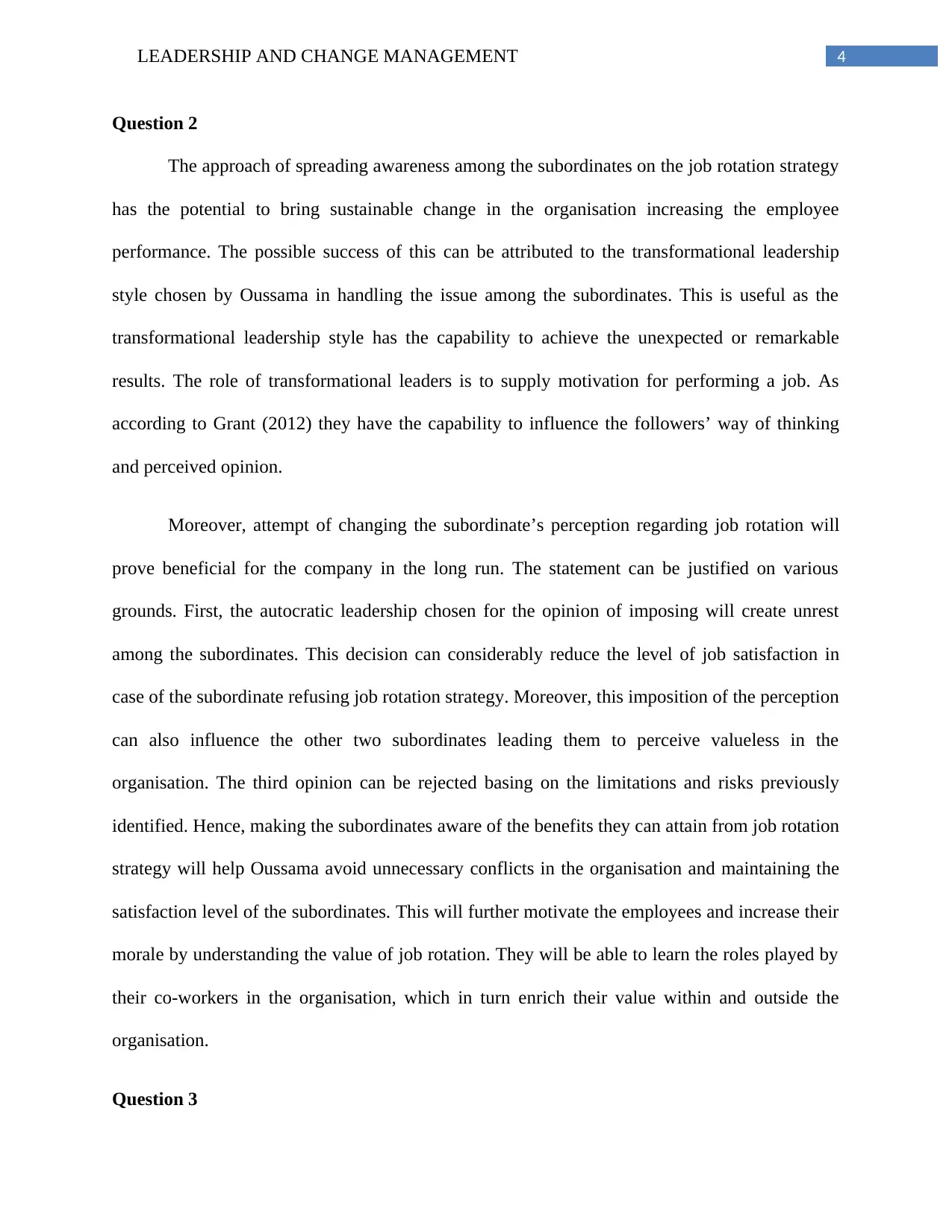
4LEADERSHIP AND CHANGE MANAGEMENT
Question 2
The approach of spreading awareness among the subordinates on the job rotation strategy
has the potential to bring sustainable change in the organisation increasing the employee
performance. The possible success of this can be attributed to the transformational leadership
style chosen by Oussama in handling the issue among the subordinates. This is useful as the
transformational leadership style has the capability to achieve the unexpected or remarkable
results. The role of transformational leaders is to supply motivation for performing a job. As
according to Grant (2012) they have the capability to influence the followers’ way of thinking
and perceived opinion.
Moreover, attempt of changing the subordinate’s perception regarding job rotation will
prove beneficial for the company in the long run. The statement can be justified on various
grounds. First, the autocratic leadership chosen for the opinion of imposing will create unrest
among the subordinates. This decision can considerably reduce the level of job satisfaction in
case of the subordinate refusing job rotation strategy. Moreover, this imposition of the perception
can also influence the other two subordinates leading them to perceive valueless in the
organisation. The third opinion can be rejected basing on the limitations and risks previously
identified. Hence, making the subordinates aware of the benefits they can attain from job rotation
strategy will help Oussama avoid unnecessary conflicts in the organisation and maintaining the
satisfaction level of the subordinates. This will further motivate the employees and increase their
morale by understanding the value of job rotation. They will be able to learn the roles played by
their co-workers in the organisation, which in turn enrich their value within and outside the
organisation.
Question 3
Question 2
The approach of spreading awareness among the subordinates on the job rotation strategy
has the potential to bring sustainable change in the organisation increasing the employee
performance. The possible success of this can be attributed to the transformational leadership
style chosen by Oussama in handling the issue among the subordinates. This is useful as the
transformational leadership style has the capability to achieve the unexpected or remarkable
results. The role of transformational leaders is to supply motivation for performing a job. As
according to Grant (2012) they have the capability to influence the followers’ way of thinking
and perceived opinion.
Moreover, attempt of changing the subordinate’s perception regarding job rotation will
prove beneficial for the company in the long run. The statement can be justified on various
grounds. First, the autocratic leadership chosen for the opinion of imposing will create unrest
among the subordinates. This decision can considerably reduce the level of job satisfaction in
case of the subordinate refusing job rotation strategy. Moreover, this imposition of the perception
can also influence the other two subordinates leading them to perceive valueless in the
organisation. The third opinion can be rejected basing on the limitations and risks previously
identified. Hence, making the subordinates aware of the benefits they can attain from job rotation
strategy will help Oussama avoid unnecessary conflicts in the organisation and maintaining the
satisfaction level of the subordinates. This will further motivate the employees and increase their
morale by understanding the value of job rotation. They will be able to learn the roles played by
their co-workers in the organisation, which in turn enrich their value within and outside the
organisation.
Question 3
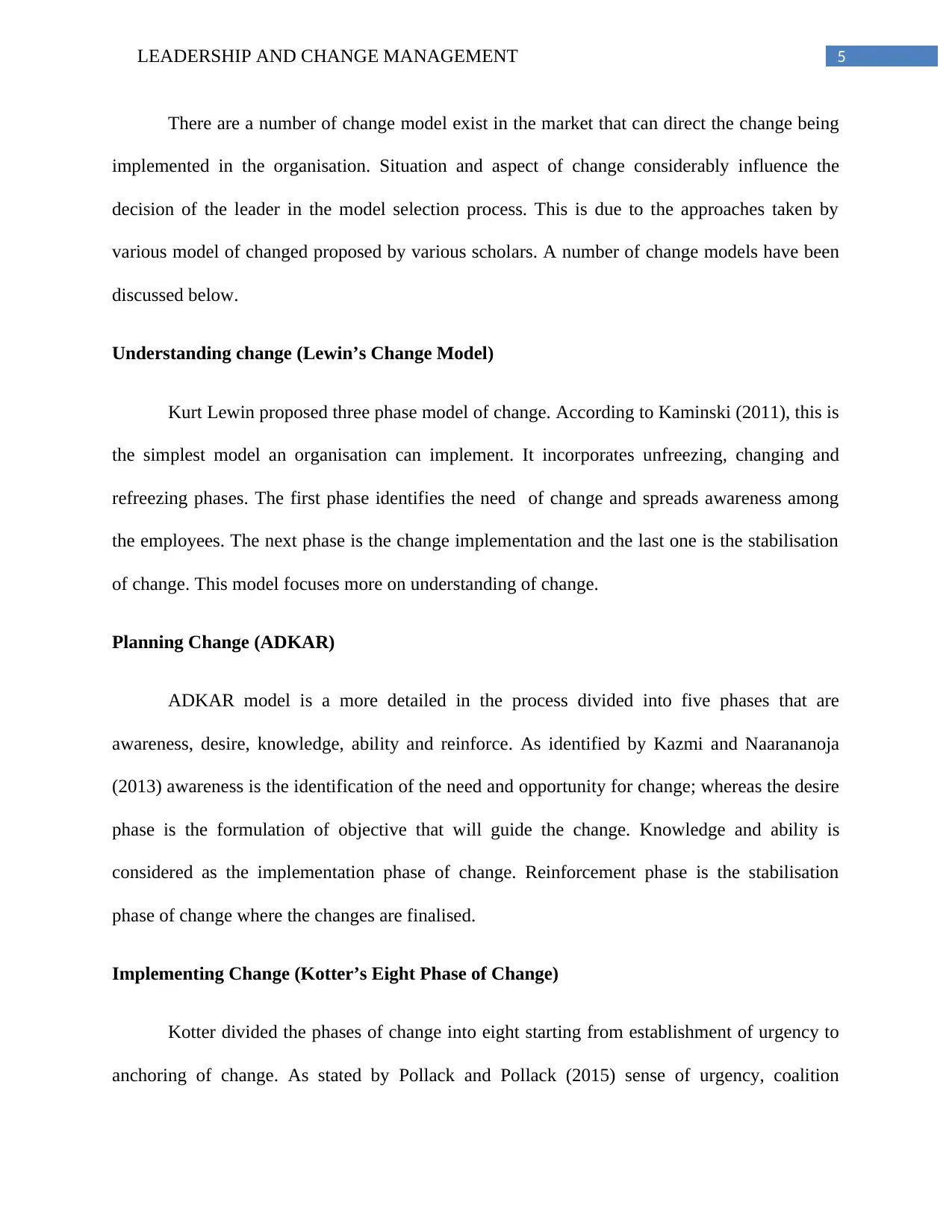
5LEADERSHIP AND CHANGE MANAGEMENT
There are a number of change model exist in the market that can direct the change being
implemented in the organisation. Situation and aspect of change considerably influence the
decision of the leader in the model selection process. This is due to the approaches taken by
various model of changed proposed by various scholars. A number of change models have been
discussed below.
Understanding change (Lewin’s Change Model)
Kurt Lewin proposed three phase model of change. According to Kaminski (2011), this is
the simplest model an organisation can implement. It incorporates unfreezing, changing and
refreezing phases. The first phase identifies the need of change and spreads awareness among
the employees. The next phase is the change implementation and the last one is the stabilisation
of change. This model focuses more on understanding of change.
Planning Change (ADKAR)
ADKAR model is a more detailed in the process divided into five phases that are
awareness, desire, knowledge, ability and reinforce. As identified by Kazmi and Naarananoja
(2013) awareness is the identification of the need and opportunity for change; whereas the desire
phase is the formulation of objective that will guide the change. Knowledge and ability is
considered as the implementation phase of change. Reinforcement phase is the stabilisation
phase of change where the changes are finalised.
Implementing Change (Kotter’s Eight Phase of Change)
Kotter divided the phases of change into eight starting from establishment of urgency to
anchoring of change. As stated by Pollack and Pollack (2015) sense of urgency, coalition
There are a number of change model exist in the market that can direct the change being
implemented in the organisation. Situation and aspect of change considerably influence the
decision of the leader in the model selection process. This is due to the approaches taken by
various model of changed proposed by various scholars. A number of change models have been
discussed below.
Understanding change (Lewin’s Change Model)
Kurt Lewin proposed three phase model of change. According to Kaminski (2011), this is
the simplest model an organisation can implement. It incorporates unfreezing, changing and
refreezing phases. The first phase identifies the need of change and spreads awareness among
the employees. The next phase is the change implementation and the last one is the stabilisation
of change. This model focuses more on understanding of change.
Planning Change (ADKAR)
ADKAR model is a more detailed in the process divided into five phases that are
awareness, desire, knowledge, ability and reinforce. As identified by Kazmi and Naarananoja
(2013) awareness is the identification of the need and opportunity for change; whereas the desire
phase is the formulation of objective that will guide the change. Knowledge and ability is
considered as the implementation phase of change. Reinforcement phase is the stabilisation
phase of change where the changes are finalised.
Implementing Change (Kotter’s Eight Phase of Change)
Kotter divided the phases of change into eight starting from establishment of urgency to
anchoring of change. As stated by Pollack and Pollack (2015) sense of urgency, coalition
⊘ This is a preview!⊘
Do you want full access?
Subscribe today to unlock all pages.

Trusted by 1+ million students worldwide

6LEADERSHIP AND CHANGE MANAGEMENT
creation and development of vision are the developmental phase of change. Sharing vision,
obstacles clearance and short term wins are considered as the implementation of change.
Solidification of change includes the build on change and the anchoring phase as proposed by
Kotter.
As identified by Hayes (2014), above mentioned models can be broken down into three
primary phases that are understanding phase, implementation phase and stabilising phase. It is
important for the manager to follow the phases as they have specific role in the process of
change. As stated by Cameron and Green (2015) the understanding phase helps the manager to in
identification of the necessity of change and making preparation. The preparation involves
spreading awareness among the subordinates, objective formulation and identification of change
process. The later phase of change management is the implementation that involves the
communication of change and preparing employees for change. The last phase involves
finalising the decisions taken in favour of change to stabilising the implemented change.
Question 4
Torppa and Smith (2011) identified the necessity of proper communication for surviving
in the changing environment of the organisation. It is the responsibility of the manager to
communicate the change that is being implemented in the organisation to maintain the efficiency
of the employees. Transparency in communication will help the employees to understand the
nature of change and adopt themselves accordingly to provide maximum output. Their study
supports the statement with the result that indicates that 66% of the respondents the importance
for structure, 57% find it important for motivating the employees and 42% identified the change
in communication plan as adverse.
creation and development of vision are the developmental phase of change. Sharing vision,
obstacles clearance and short term wins are considered as the implementation of change.
Solidification of change includes the build on change and the anchoring phase as proposed by
Kotter.
As identified by Hayes (2014), above mentioned models can be broken down into three
primary phases that are understanding phase, implementation phase and stabilising phase. It is
important for the manager to follow the phases as they have specific role in the process of
change. As stated by Cameron and Green (2015) the understanding phase helps the manager to in
identification of the necessity of change and making preparation. The preparation involves
spreading awareness among the subordinates, objective formulation and identification of change
process. The later phase of change management is the implementation that involves the
communication of change and preparing employees for change. The last phase involves
finalising the decisions taken in favour of change to stabilising the implemented change.
Question 4
Torppa and Smith (2011) identified the necessity of proper communication for surviving
in the changing environment of the organisation. It is the responsibility of the manager to
communicate the change that is being implemented in the organisation to maintain the efficiency
of the employees. Transparency in communication will help the employees to understand the
nature of change and adopt themselves accordingly to provide maximum output. Their study
supports the statement with the result that indicates that 66% of the respondents the importance
for structure, 57% find it important for motivating the employees and 42% identified the change
in communication plan as adverse.
Paraphrase This Document
Need a fresh take? Get an instant paraphrase of this document with our AI Paraphraser
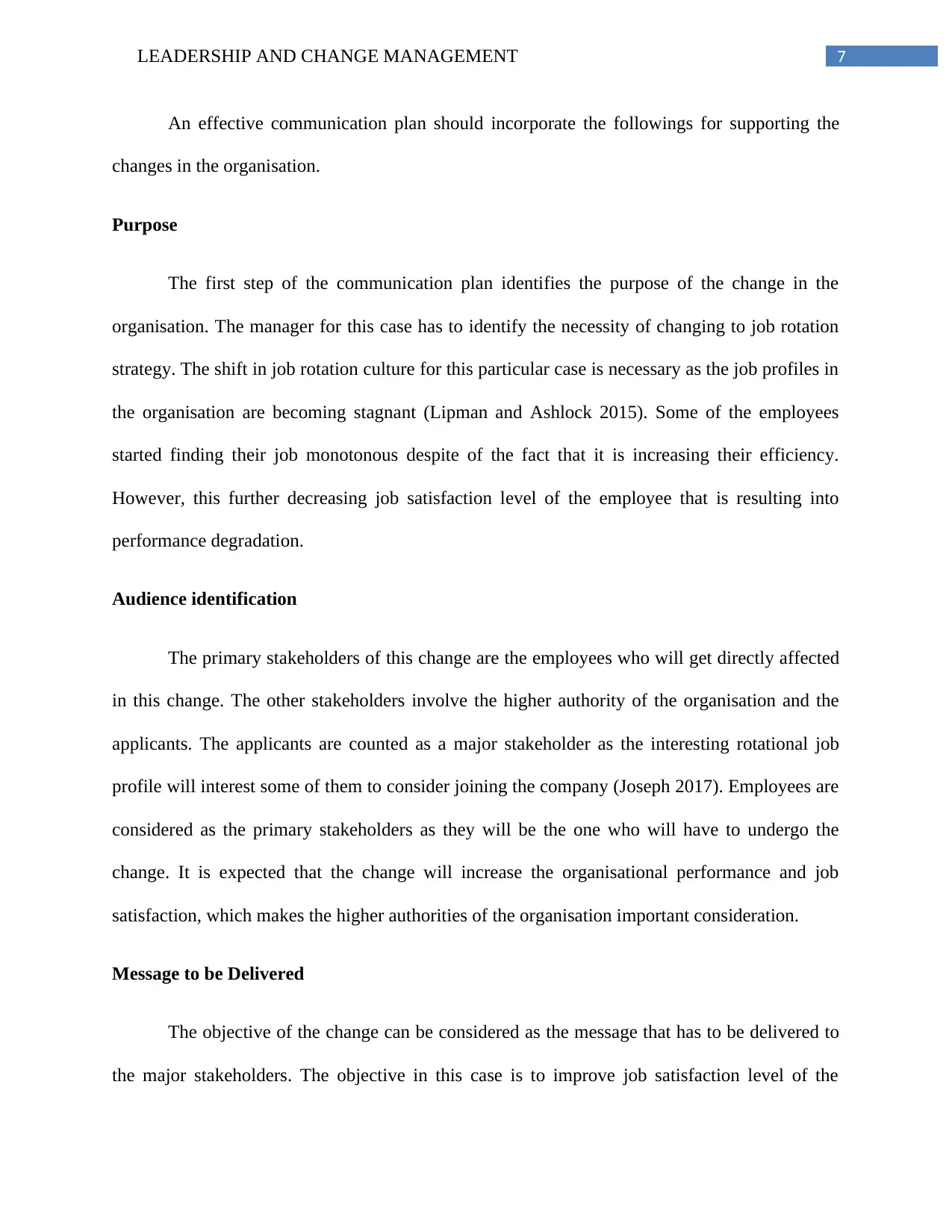
7LEADERSHIP AND CHANGE MANAGEMENT
An effective communication plan should incorporate the followings for supporting the
changes in the organisation.
Purpose
The first step of the communication plan identifies the purpose of the change in the
organisation. The manager for this case has to identify the necessity of changing to job rotation
strategy. The shift in job rotation culture for this particular case is necessary as the job profiles in
the organisation are becoming stagnant (Lipman and Ashlock 2015). Some of the employees
started finding their job monotonous despite of the fact that it is increasing their efficiency.
However, this further decreasing job satisfaction level of the employee that is resulting into
performance degradation.
Audience identification
The primary stakeholders of this change are the employees who will get directly affected
in this change. The other stakeholders involve the higher authority of the organisation and the
applicants. The applicants are counted as a major stakeholder as the interesting rotational job
profile will interest some of them to consider joining the company (Joseph 2017). Employees are
considered as the primary stakeholders as they will be the one who will have to undergo the
change. It is expected that the change will increase the organisational performance and job
satisfaction, which makes the higher authorities of the organisation important consideration.
Message to be Delivered
The objective of the change can be considered as the message that has to be delivered to
the major stakeholders. The objective in this case is to improve job satisfaction level of the
An effective communication plan should incorporate the followings for supporting the
changes in the organisation.
Purpose
The first step of the communication plan identifies the purpose of the change in the
organisation. The manager for this case has to identify the necessity of changing to job rotation
strategy. The shift in job rotation culture for this particular case is necessary as the job profiles in
the organisation are becoming stagnant (Lipman and Ashlock 2015). Some of the employees
started finding their job monotonous despite of the fact that it is increasing their efficiency.
However, this further decreasing job satisfaction level of the employee that is resulting into
performance degradation.
Audience identification
The primary stakeholders of this change are the employees who will get directly affected
in this change. The other stakeholders involve the higher authority of the organisation and the
applicants. The applicants are counted as a major stakeholder as the interesting rotational job
profile will interest some of them to consider joining the company (Joseph 2017). Employees are
considered as the primary stakeholders as they will be the one who will have to undergo the
change. It is expected that the change will increase the organisational performance and job
satisfaction, which makes the higher authorities of the organisation important consideration.
Message to be Delivered
The objective of the change can be considered as the message that has to be delivered to
the major stakeholders. The objective in this case is to improve job satisfaction level of the

8LEADERSHIP AND CHANGE MANAGEMENT
employees working in the organisation. This is to retain the employees for longer period of time.
It will further help in morale stability of the employees and increase their market value ((Joseph
2017). Finally, the change will serve as a promoter to increase the organisational performance.
All these objectives are related to each other and facilitates in attaining the objectives.
Media Considered
It is important for considering multiple media for communicating the message to the
stakeholders. Electronic mail, online update and physical mode of communication have to be
considered in this case (Lipman and Ashlock 2015). The email and physical communication will
be utilised for communicating the change to the employees and the higher authorities of the
organisation through meeting. Online update of the job profile will be used for communicating
the message to the possible applicants.
Change Plan Implementation and Plan for Emergency
The detail of the plan along with the emergency plan will be communicated only to the
employees and the higher authorities of the higher authorities of the company. This will help
maintaining the transparency of the plan, which will further help the stakeholders to act
accordingly for achieving success from the change.
Evaluation
employees working in the organisation. This is to retain the employees for longer period of time.
It will further help in morale stability of the employees and increase their market value ((Joseph
2017). Finally, the change will serve as a promoter to increase the organisational performance.
All these objectives are related to each other and facilitates in attaining the objectives.
Media Considered
It is important for considering multiple media for communicating the message to the
stakeholders. Electronic mail, online update and physical mode of communication have to be
considered in this case (Lipman and Ashlock 2015). The email and physical communication will
be utilised for communicating the change to the employees and the higher authorities of the
organisation through meeting. Online update of the job profile will be used for communicating
the message to the possible applicants.
Change Plan Implementation and Plan for Emergency
The detail of the plan along with the emergency plan will be communicated only to the
employees and the higher authorities of the higher authorities of the company. This will help
maintaining the transparency of the plan, which will further help the stakeholders to act
accordingly for achieving success from the change.
Evaluation
⊘ This is a preview!⊘
Do you want full access?
Subscribe today to unlock all pages.

Trusted by 1+ million students worldwide
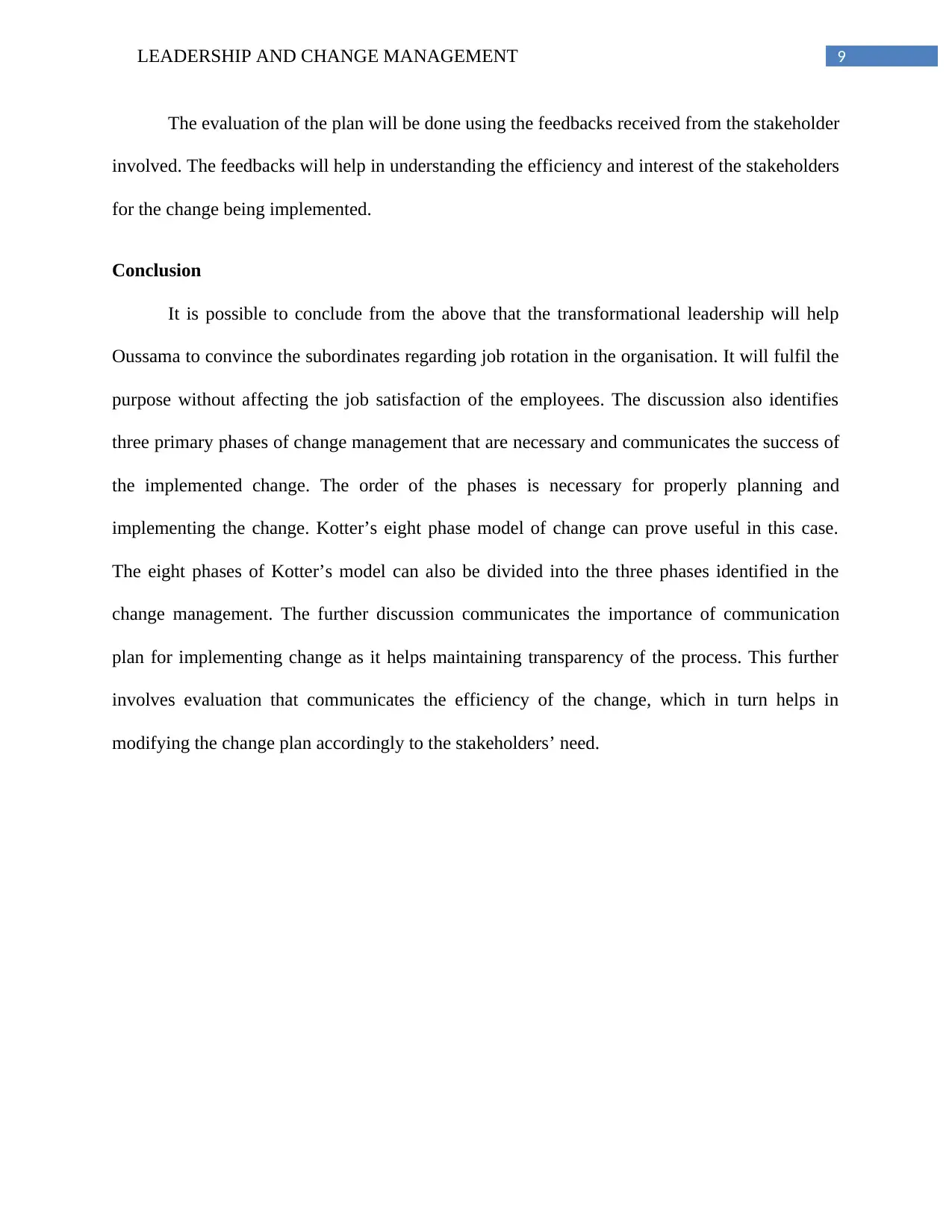
9LEADERSHIP AND CHANGE MANAGEMENT
The evaluation of the plan will be done using the feedbacks received from the stakeholder
involved. The feedbacks will help in understanding the efficiency and interest of the stakeholders
for the change being implemented.
Conclusion
It is possible to conclude from the above that the transformational leadership will help
Oussama to convince the subordinates regarding job rotation in the organisation. It will fulfil the
purpose without affecting the job satisfaction of the employees. The discussion also identifies
three primary phases of change management that are necessary and communicates the success of
the implemented change. The order of the phases is necessary for properly planning and
implementing the change. Kotter’s eight phase model of change can prove useful in this case.
The eight phases of Kotter’s model can also be divided into the three phases identified in the
change management. The further discussion communicates the importance of communication
plan for implementing change as it helps maintaining transparency of the process. This further
involves evaluation that communicates the efficiency of the change, which in turn helps in
modifying the change plan accordingly to the stakeholders’ need.
The evaluation of the plan will be done using the feedbacks received from the stakeholder
involved. The feedbacks will help in understanding the efficiency and interest of the stakeholders
for the change being implemented.
Conclusion
It is possible to conclude from the above that the transformational leadership will help
Oussama to convince the subordinates regarding job rotation in the organisation. It will fulfil the
purpose without affecting the job satisfaction of the employees. The discussion also identifies
three primary phases of change management that are necessary and communicates the success of
the implemented change. The order of the phases is necessary for properly planning and
implementing the change. Kotter’s eight phase model of change can prove useful in this case.
The eight phases of Kotter’s model can also be divided into the three phases identified in the
change management. The further discussion communicates the importance of communication
plan for implementing change as it helps maintaining transparency of the process. This further
involves evaluation that communicates the efficiency of the change, which in turn helps in
modifying the change plan accordingly to the stakeholders’ need.
Paraphrase This Document
Need a fresh take? Get an instant paraphrase of this document with our AI Paraphraser
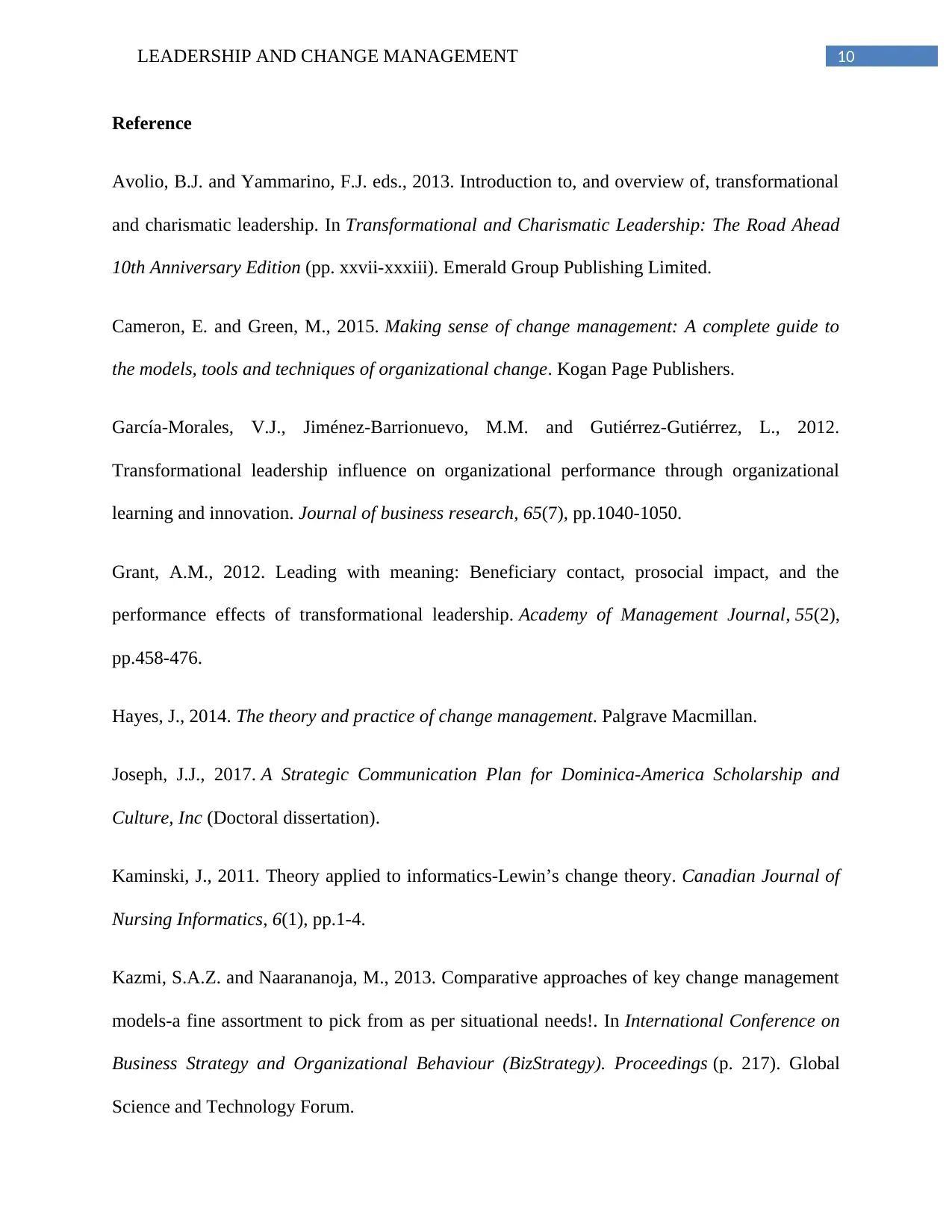
10LEADERSHIP AND CHANGE MANAGEMENT
Reference
Avolio, B.J. and Yammarino, F.J. eds., 2013. Introduction to, and overview of, transformational
and charismatic leadership. In Transformational and Charismatic Leadership: The Road Ahead
10th Anniversary Edition (pp. xxvii-xxxiii). Emerald Group Publishing Limited.
Cameron, E. and Green, M., 2015. Making sense of change management: A complete guide to
the models, tools and techniques of organizational change. Kogan Page Publishers.
García-Morales, V.J., Jiménez-Barrionuevo, M.M. and Gutiérrez-Gutiérrez, L., 2012.
Transformational leadership influence on organizational performance through organizational
learning and innovation. Journal of business research, 65(7), pp.1040-1050.
Grant, A.M., 2012. Leading with meaning: Beneficiary contact, prosocial impact, and the
performance effects of transformational leadership. Academy of Management Journal, 55(2),
pp.458-476.
Hayes, J., 2014. The theory and practice of change management. Palgrave Macmillan.
Joseph, J.J., 2017. A Strategic Communication Plan for Dominica-America Scholarship and
Culture, Inc (Doctoral dissertation).
Kaminski, J., 2011. Theory applied to informatics-Lewin’s change theory. Canadian Journal of
Nursing Informatics, 6(1), pp.1-4.
Kazmi, S.A.Z. and Naarananoja, M., 2013. Comparative approaches of key change management
models-a fine assortment to pick from as per situational needs!. In International Conference on
Business Strategy and Organizational Behaviour (BizStrategy). Proceedings (p. 217). Global
Science and Technology Forum.
Reference
Avolio, B.J. and Yammarino, F.J. eds., 2013. Introduction to, and overview of, transformational
and charismatic leadership. In Transformational and Charismatic Leadership: The Road Ahead
10th Anniversary Edition (pp. xxvii-xxxiii). Emerald Group Publishing Limited.
Cameron, E. and Green, M., 2015. Making sense of change management: A complete guide to
the models, tools and techniques of organizational change. Kogan Page Publishers.
García-Morales, V.J., Jiménez-Barrionuevo, M.M. and Gutiérrez-Gutiérrez, L., 2012.
Transformational leadership influence on organizational performance through organizational
learning and innovation. Journal of business research, 65(7), pp.1040-1050.
Grant, A.M., 2012. Leading with meaning: Beneficiary contact, prosocial impact, and the
performance effects of transformational leadership. Academy of Management Journal, 55(2),
pp.458-476.
Hayes, J., 2014. The theory and practice of change management. Palgrave Macmillan.
Joseph, J.J., 2017. A Strategic Communication Plan for Dominica-America Scholarship and
Culture, Inc (Doctoral dissertation).
Kaminski, J., 2011. Theory applied to informatics-Lewin’s change theory. Canadian Journal of
Nursing Informatics, 6(1), pp.1-4.
Kazmi, S.A.Z. and Naarananoja, M., 2013. Comparative approaches of key change management
models-a fine assortment to pick from as per situational needs!. In International Conference on
Business Strategy and Organizational Behaviour (BizStrategy). Proceedings (p. 217). Global
Science and Technology Forum.
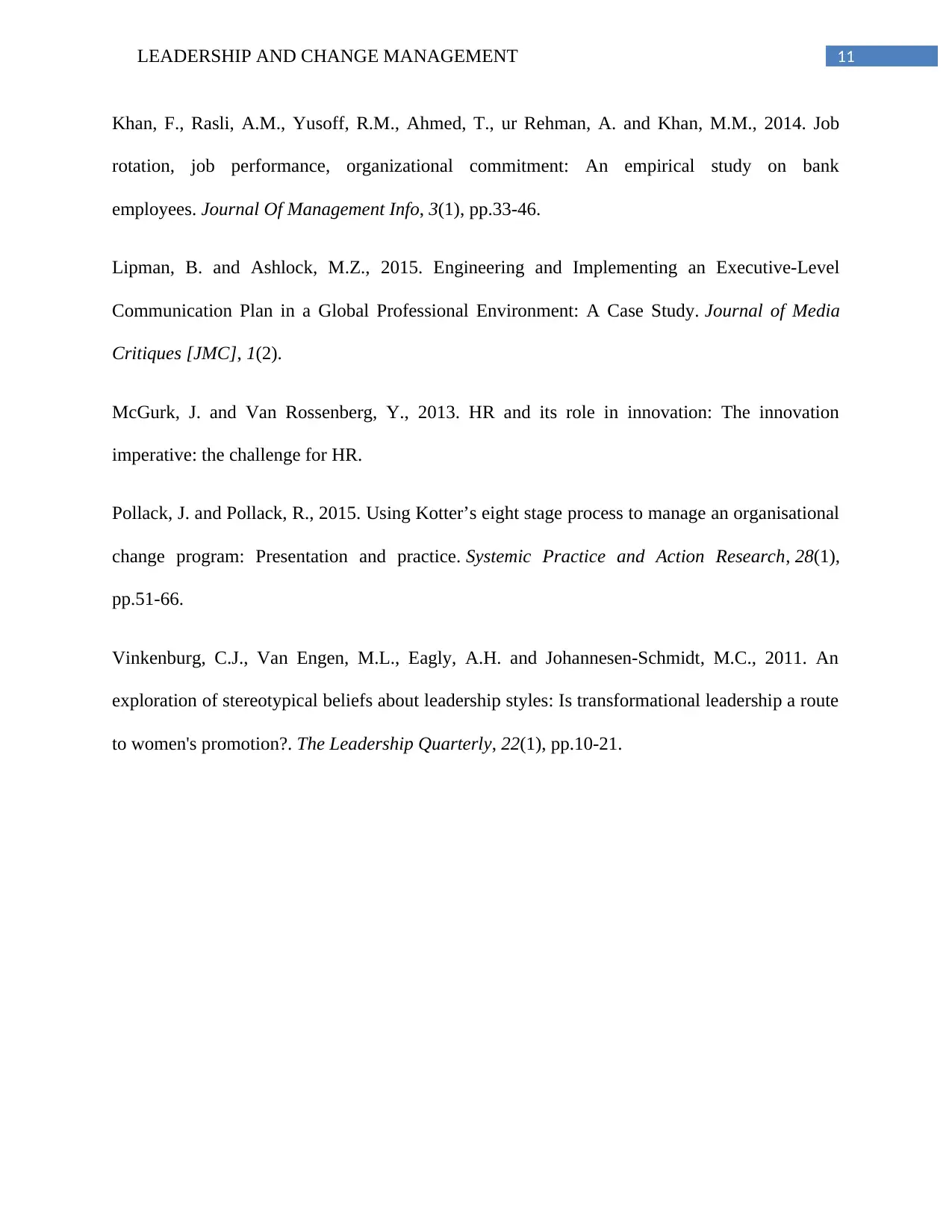
11LEADERSHIP AND CHANGE MANAGEMENT
Khan, F., Rasli, A.M., Yusoff, R.M., Ahmed, T., ur Rehman, A. and Khan, M.M., 2014. Job
rotation, job performance, organizational commitment: An empirical study on bank
employees. Journal Of Management Info, 3(1), pp.33-46.
Lipman, B. and Ashlock, M.Z., 2015. Engineering and Implementing an Executive-Level
Communication Plan in a Global Professional Environment: A Case Study. Journal of Media
Critiques [JMC], 1(2).
McGurk, J. and Van Rossenberg, Y., 2013. HR and its role in innovation: The innovation
imperative: the challenge for HR.
Pollack, J. and Pollack, R., 2015. Using Kotter’s eight stage process to manage an organisational
change program: Presentation and practice. Systemic Practice and Action Research, 28(1),
pp.51-66.
Vinkenburg, C.J., Van Engen, M.L., Eagly, A.H. and Johannesen-Schmidt, M.C., 2011. An
exploration of stereotypical beliefs about leadership styles: Is transformational leadership a route
to women's promotion?. The Leadership Quarterly, 22(1), pp.10-21.
Khan, F., Rasli, A.M., Yusoff, R.M., Ahmed, T., ur Rehman, A. and Khan, M.M., 2014. Job
rotation, job performance, organizational commitment: An empirical study on bank
employees. Journal Of Management Info, 3(1), pp.33-46.
Lipman, B. and Ashlock, M.Z., 2015. Engineering and Implementing an Executive-Level
Communication Plan in a Global Professional Environment: A Case Study. Journal of Media
Critiques [JMC], 1(2).
McGurk, J. and Van Rossenberg, Y., 2013. HR and its role in innovation: The innovation
imperative: the challenge for HR.
Pollack, J. and Pollack, R., 2015. Using Kotter’s eight stage process to manage an organisational
change program: Presentation and practice. Systemic Practice and Action Research, 28(1),
pp.51-66.
Vinkenburg, C.J., Van Engen, M.L., Eagly, A.H. and Johannesen-Schmidt, M.C., 2011. An
exploration of stereotypical beliefs about leadership styles: Is transformational leadership a route
to women's promotion?. The Leadership Quarterly, 22(1), pp.10-21.
⊘ This is a preview!⊘
Do you want full access?
Subscribe today to unlock all pages.

Trusted by 1+ million students worldwide
1 out of 12
Related Documents
Your All-in-One AI-Powered Toolkit for Academic Success.
+13062052269
info@desklib.com
Available 24*7 on WhatsApp / Email
![[object Object]](/_next/static/media/star-bottom.7253800d.svg)
Unlock your academic potential
Copyright © 2020–2025 A2Z Services. All Rights Reserved. Developed and managed by ZUCOL.




